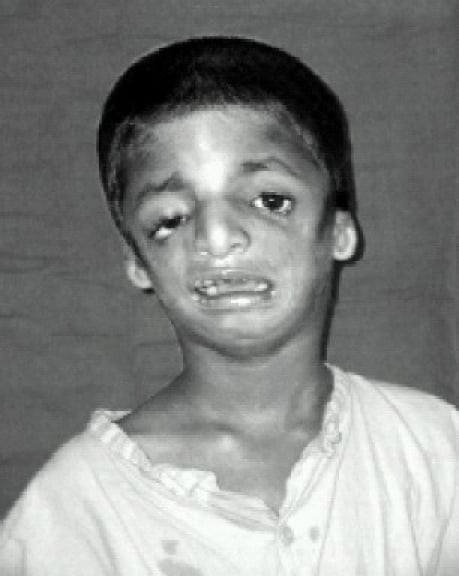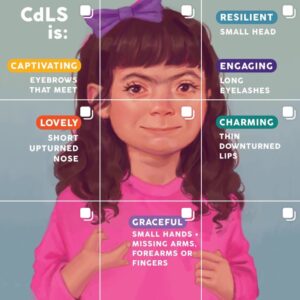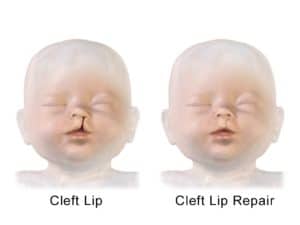Treacher-Collins syndrome is also known as Lancaster disease or Franceschetti-Zwahlen-Klein syndrome. It is a rare genetic disorder manifested by the head’s bony and soft tissue deformities, especially ears, orbit, facial bones, and chin.
Dr. Treacher Collins, an Ophthalmologist, first mentioned this entity in a paper presented to the Opthalmology Society, UK in 1933.
Genetic factors
It is mostly an autosomal dominant disorder, but more than 50 % of cases are due to new mutations. Affected genes are TCOF1, POLR1C, or POLR1D.
Epidemiology
Worldwide it is estimated to happen in one in 50 thousand live births. The male to female ratio is 1:1. It occurs equally in all races.
Features of Lancaster disease
Mostly the disease presents with abnormalities solely affecting the face, ears, and eyes.
- Maxillae- Small and underdeveloped giving the false impression of a large nose.
- Mandible- small, gives the appearance of a receding chin which incites respiratory and feeding problems in the early days of life due to frequent dropping back of tiny underdeveloped jaw by falling back of the tongue to the upper airway during relaxation of muscles, especially in sleep. Putting these babies on their sides during sleep is advised to prevent this occurrence.
- Eyes- Downward slant with colobomas noted. Vision may be affected due to underdeveloped orbit and orbital muscles.
- Ears- External ear is mostly rotated, malformed, or small. The absence of an external auditory canal is also noted. More than 50 percent of cases present with a conductive type of hearing loss.
- Others- Cleft palate, heart defect, and abnormalities in teeth eruption also happen.
- Intelligence- Normal

Diagnosis
- Diagnosis before birth: Mutations in the main genes responsible can be found out with chorionic villus sampling or amniocentesis. Ultrasonography of biophysical profile would be able to detect major craniofacial bony abnormalities but unfortunately likely to miss subtle changes.
- Diagnosis after birth: It is a clinical diagnosis in most cases. MRI and CT scans can be used to identify specific changes in the bony structure. As the clinical presentation closely resembles other genetic disorders such as Goldenhar Syndrome or CHARGE syndrome, OMENS classification was developed to differentiate the diseases and also its severity. It is described below-
OMENS Classification
Orbital symmetry
- O0: Normal orbital size, position
- O1: Abnormal orbit size
- O2: Abnormal orbit position.
- O3: Abnormal orbit position, size
Mandible
- M0: Normal mandible
- M1: Small mandible and glenoid fossa with short ramus
- M2: Ramus short and abnormally shaped
- 2A: Glenoid fossa in an anatomically acceptable position
- 2B: Tempero mandibular joint inferiorly (TMJ), medially, anteriorly displaced, with the severely hypoplastic condyle
- M3: Complete absence of ramus, glenoid fossa, and TMJ
Ear
- E0: Normal ear
- E1: Minor hypoplasia and cupping with all structures present
- E2: Absence of external auditory canal with variable hypoplasia of the auricle
- E3: Malposition of the lobule with absent auricle, lobular remnant usually inferior anteriorly displaced
Facial nerve
- N0: No facial nerve involvement
- N1: Upper facial nerve involvement (temporal or zygomatic branches)
- N2: Lower facial nerve involvement (buccal, mandibular or cervical)
- N3: All branches affected
Soft tissue
- S0: No soft tissue or muscle deficiency
- S1: Minimal tissue or muscle deficiency
- S2: Moderate tissue or muscle deficiency
- S3: Severe tissue or muscle deficiency
Differential diagnosis
- Acrofacial dysostosis
- Goldenhar syndrome
- X-linked dominant maxillofacial dysostosis
Treatment
- Early feeding and respiratory difficulties must be recognized early and managed appropriately. Nasogastric feeding may be necessary if sucking is difficult and in extreme respiratory problems temporary tracheostomy is indicated. Putting the child into side position during sleep is also recommended.
- Early diagnosis of conductive deafness is very important. Otherwise learning difficulty may ensue. Hearing aids from an early age facilitates good achievement in all developmental fields.
- Surgery may be needed for cleft palate if it is present.
- Emotional support should be prioritized as the affected children are frequently bullied and teased in school.
- Various reconstructive plastic surgeries can improve appearance and functionality.
Prognosis/ long term outcome of Lancaster disease
- Life expectancy is normal.
- IQ is normal.
- A normal career choice is open although deafness may deter jobs in certain fields.
- Genetic counseling should be done before pregnancy is embarked upon.
- Please write to us in the comment section if you have liked the article. Check our services.
- If you want to learn more about Treacher Collins Syndrome then check this article: https://www.nature.com/articles/ejhg2008221/




